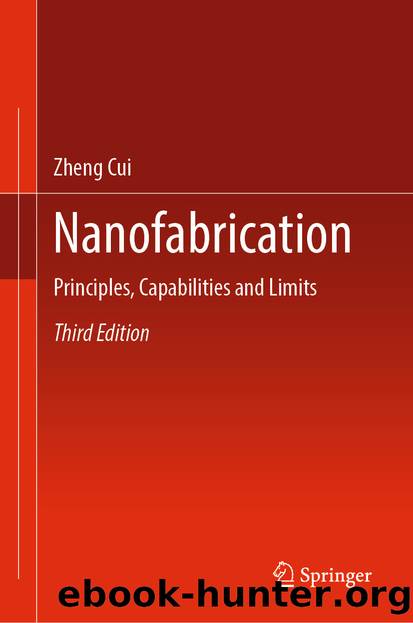Nanofabrication by Zheng Cui

Author:Zheng Cui
Language: eng
Format: epub
ISBN: 9783031625466
Publisher: Springer International Publishing
6.2 Thermal Nanoimprint
Nanoimprint relying on heating and pressing was the first proposed replication process at nanometer scale [1]. It can often be confused with hot embossing, as hot embossing refers to the same replication process that relies on heating and pressing a stamp into plastics or other ductile surfaces. The general consensus is that hot embossing refers to thermal imprint of large structures which is above a micrometer or tens of micrometers, while thermal nanoimprint refers to making small structures often less than a micrometer. Therefore, the process to make plastic microfluidic devices, which are normally of tens or hundreds of micrometers in structure dimension, is called hot embossing, not nanoimprinting. Nanoimprint has much broader meaning, because some of the nanoimprint techniques may not involve heating and pressing at all, as introduced later in this chapter.
The basic process of thermal nanoimprint lithography (T-NIL) can be schematically illustrated by Fig. 6.1. A thin layer of polymer (100â200 nm thickness) coated on a flat substrate is first heated to about 50â100 °C above its glass transition temperature (Tg) so that it becomes soften. A stamp with surface relief structures is pressed into the thin polymer layer at pressure of around 50â100 bars (725â1450 psi), depending on the viscosity of molten polymer. The imprint depth is slightly less than the polymer layer thickness so that the stamp surface does not have hard contact with the substrate to prevent any damage to the stamp. The next step is to decouple the stamp from the polymer layer (demolding), while it is still soft. The temperature and pressure at different stage of imprinting are plotted in Fig. 6.2. Normally at about 10 °C below the Tg, the imprinting pressure is released. When cooling down to about 50 °C, the stamp and the imprinted sample are separated. After the separation of stamp, an impression of the stamp pattern is left in the polymer layer. The final step is to remove the residual polymer inside the imprinted pattern areas by reactive ion etching, to lay bare the substrate surface. The polymer patterns obtained after removal of residual polymer are in the same form as those obtained by optical lithography or e-beam lithography of resists. There are a number of key factors which are related to faithful replication of sub-100 nm features in the thermal press nanoimprinting process, such as the stamp, the polymer, the separation of stamp and polymer (demolding), and alignment if multilevel nanoimprinting is needed. These factors are discussed in the following sections.
Fig. 6.1Schematic of nanoimprinting process
Download
This site does not store any files on its server. We only index and link to content provided by other sites. Please contact the content providers to delete copyright contents if any and email us, we'll remove relevant links or contents immediately.
Learning SQL by Alan Beaulieu(6239)
Weapons of Math Destruction by Cathy O'Neil(6220)
Digital Minimalism by Cal Newport;(5707)
iGen by Jean M. Twenge(5387)
Sapiens by Yuval Noah Harari(5325)
The Age of Surveillance Capitalism by Shoshana Zuboff(4252)
Elon Musk by Ashlee Vance(4089)
Thing Explainer by Randall Munroe(3911)
Apollo 8 by Jeffrey Kluger(3672)
Future Crimes by Marc Goodman(3566)
The Science Book (Big Ideas Simply Explained) by DK(3256)
Who Can You Trust? by Rachel Botsman(3112)
The Innovators: How a Group of Hackers, Geniuses, and Geeks Created the Digital Revolution by Walter Isaacson(3008)
I Live in the Future & Here's How It Works by Nick Bilton(2963)
Infinite Energy Technologies by Finley Eversole(2954)
Steve Jobs by Walter Isaacson(2863)
Dawn of the New Everything by Jaron Lanier(2751)
Chernobyl by Serhii Plokhy(2516)
Ben Franklin's Almanac by Candace Fleming(2497)
